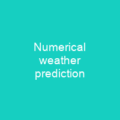Economic Forecasting: The Art of Predicting the Future
Imagine trying to predict the weather, but instead of clouds and rain, you’re dealing with economies, markets, and financial trends. That’s what economic forecasting is all about—making educated guesses about how the economy will behave in the future. How do economists manage this daunting task?
The Tools of Economic Forecasting
Economists use a wide array of tools and information to make their predictions. From macroeconomic data like GDP growth rates, to microeconomic factors such as consumer behavior, they gather every piece of relevant information available. Is there any single tool that stands out in the arsenal of an economist?
Machine learning and advanced statistical models are increasingly becoming integral parts of this process. These tools help economists analyze vast amounts of data to identify patterns and make predictions with greater accuracy. However, it’s not just about numbers; human intuition plays a crucial role too.
The Importance of Risk Assessment
Risk assessment is another critical component in economic forecasting. Economists consider various risks that could impact the economy, such as political instability or natural disasters. By factoring these risks into their models, they can provide a more realistic and comprehensive forecast. How do you balance optimism with caution when making predictions?
The Uses of Economic Forecasts
Economic forecasts serve multiple purposes. They help businesses plan for the future, governments set policies, and investors make informed decisions. For instance, a company might use an economic forecast to decide whether to expand its operations or invest in new technology. Can you think of another scenario where economic forecasts are crucial?
The Challenges of Forecasting
Economic forecasting is not without its challenges. Forecasts are based on sample data, which introduces uncertainty. Economists must conduct rigorous statistical tests and develop models to determine the best relationships between variables. How do you deal with the inherent uncertainties in economic forecasts?
The Role of Consensus Forecasts
Consensus forecasts are created by combining predictions from various sources, such as national governments, banks, and private research firms. These consensus forecasts often yield lower mean-square errors than individual forecasts. Why do economists rely on multiple sources to create a more accurate forecast?
The Sources of Economic Forecasts
A variety of institutions provide economic forecasts, including the OECD’s Economic Outlook, the IMF’s World Economic Outlook report, and regional reports from organizations like the World Bank. Private companies such as The Conference Board and Lombard Street Research also contribute to this landscape. Which source do you trust more for economic forecasts?
The Future of Economic Forecasting
The field of economic forecasting is constantly evolving, with new technologies and methodologies being developed all the time. As we move forward, economists will continue to refine their models and improve their accuracy. What do you think the future holds for economic forecasting?
Conclusion
Economic forecasting is a complex but essential process that helps us navigate the uncertain world of finance and economics. By combining data, tools, and human expertise, economists can provide valuable insights into the future. Whether you’re a business owner, investor, or simply curious about the economy, understanding economic forecasts can help you make better decisions. After all, in this ever-changing landscape, knowing what’s coming next is half the battle.

You want to know more about Economic forecasting?
This page is based on the article Economic forecasting published in Wikipedia (retrieved on November 29, 2024) and was automatically summarized using artificial intelligence.






